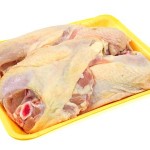
The meat industry likes to say that factory farms are modern, efficient and produce cheap food. But in reality, factory farms increase the risk of pathogens like E. coli and salmonella that cause food-borne illness in people.
You might be surprised to find out, in this quiz from the Natural Resources Defense Council (NRDC), the high percentage of supermarket chicken that has E. coli.

The bacteria is commonly found in the lower intestine of warm-blooded organisms and, when people eat food contaminated with E. coli, they can develop diarrhea, urinary tract infections, respiratory illness and pneumonia and other illnesses.
You can guard against food-borne illnesses by making sure your food handling practices at home are effective. Here’s a list from the U.S Food and Drug Administration of four steps to food safety in your kitchen:
1. Wash hands and surfaces often. Bacteria can spread throughout the kitchen and get onto hands, cutting boards, utensils, counter tops and food.
Wash your hands with warm water and soap for at least 20 seconds before and after handling food and after using the bathroom, changing diapers and handling pets.
Wash your cutting boards, dishes, utensils and counter tops with hot soapy water after preparing each food item and before you go on to the next food.
Consider using paper towels to clean up kitchen surfaces. If you use cloth towels wash them often in the hot cycle of your washing machine.
Rinse fresh fruits and vegetables under running tap water, including those with skins and rinds that are not eaten.
Rub firm-skin fruits and vegetables under running tap water or scrub with a clean vegetable brush while rinsing with running tap water.
Clean canned goods lids before opening.
2. Separate raw meats from other foods. Cross-contamination can occur when bacteria are spread from one food to another. This is especially common when handling raw meat, poultry, seafood and eggs. The key is to keep these foods—and their juices—away from ready-to-eat foods.
Separate raw meat, poultry, seafood and eggs from other foods in your grocery shopping cart, grocery bags and in your refrigerator.
Use one cutting board for fresh produce and a separate one for raw meat, poultry and seafood.
Never place cooked food on a plate that previously held raw meat, poultry, seafood or eggs.
Don’t reuse marinades used on raw foods unless you bring them to a boil first.
3. Cook to the right temperatures. Food is safely cooked when it reaches a high enough internal temperature to kill the harmful bacteria that cause illness.
Use a food thermometer to measure the internal temperature of cooked foods. Check the internal temperature in several places to make sure that the meat, poultry, seafood, eggs or dishes containing eggs are cooked to safe minimum internal temperatures as shown in the Safe Cooking Temperatures Chart. Color is not a reliable indicator of doneness.
Cook eggs until the yolk and white are firm. Only use recipes in which eggs are cooked or heated thoroughly.
When cooking in a microwave oven, cover food, stir and rotate for even cooking. Or rotate the dish by hand once or twice during cooking. Always allow standing time, which completes the cooking, before checking the internal temperature with a food thermometer. Food is done when it reaches the safe minimum internal temperature.
Bring sauces, soups and gravy to a boil when reheating.
4. Refrigerate foods promptly. Cold temperatures slow the growth of harmful bacteria. Do not over-stuff the refrigerator. Cold air must circulate to help keep food safe. Keeping a constant refrigerator temperature of 40 degrees Fahrenheit or below is one of the most effective ways to reduce the risk of foodborne illness. Use an appliance thermometer to be sure the temperature is consistently at 40 degrees or below and the freezer temperature is zero degrees or below.
Refrigerate or freeze meat, poultry, eggs, seafood and other perishables within two hours of cooking or purchasing. Refrigerate within one hour if the temperature outside is above 90ºF.
Never thaw food at room temperature, such as on the counter top. Food must be kept at a safe temperature during thawing : in the refrigerator, in cold water, and in the microwave. Food thawed in cold water or in the microwave should be cooked immediately.
Always marinate food in the refrigerator.
Divide large amounts of leftovers into shallow containers for quicker cooling in the refrigerator.
Use or discard refrigerated food on a regular basis. Follow the recommendations in the USDA’s Refrigerator & Freezer Storage Chart.
Visit EcoWatch’s FOOD page for more related news on this topic.


Leave a Reply
You must be logged in to post a comment.